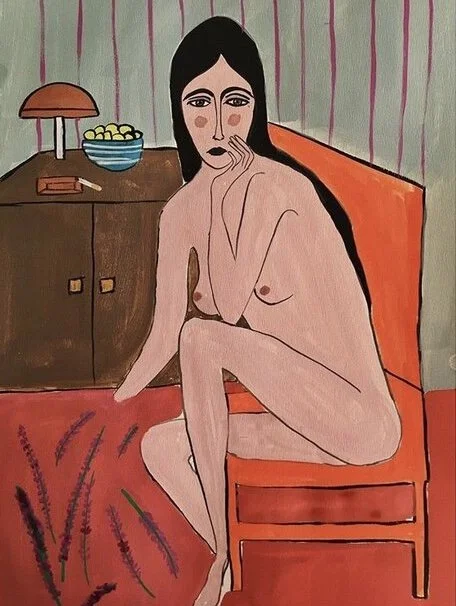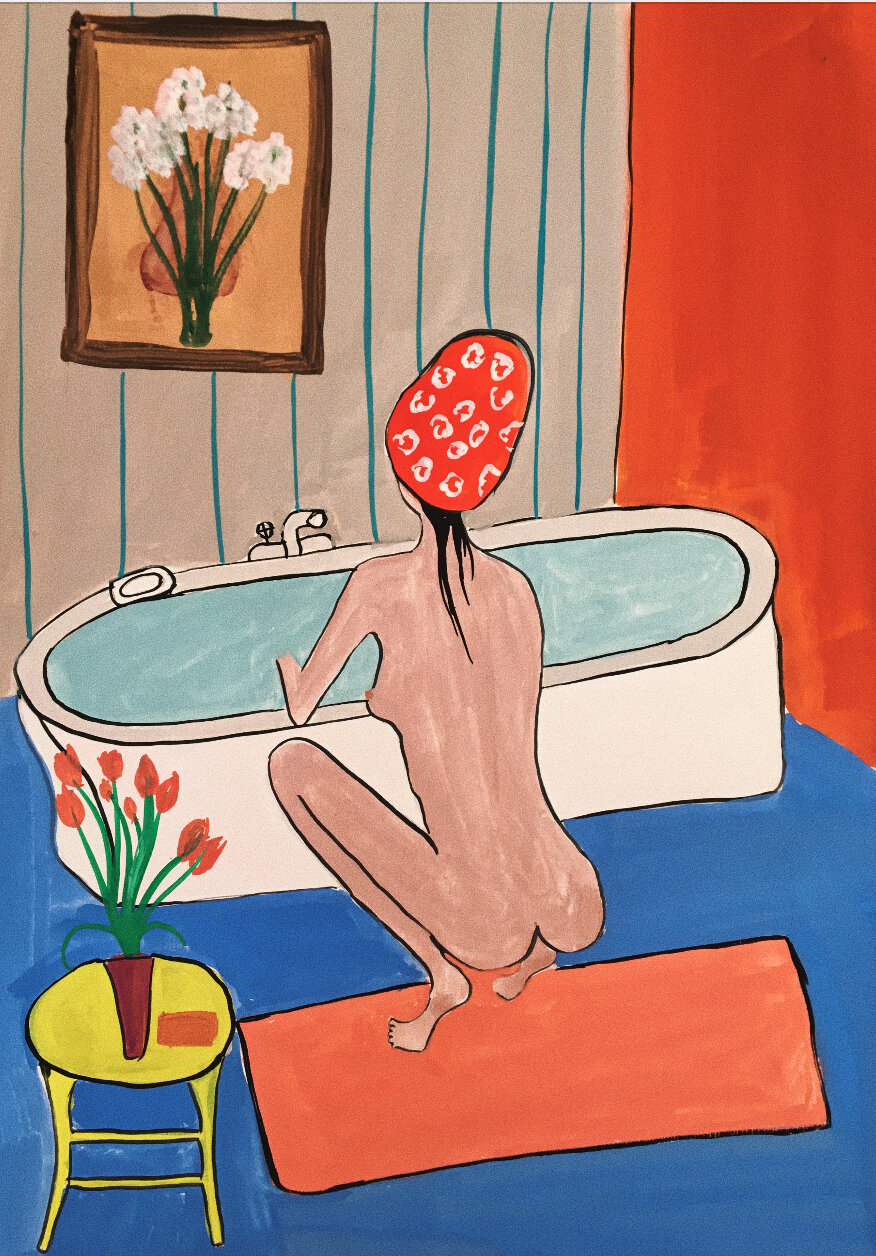Art and Memory: Visions of Beirut
A Date with the Night by Maria Kassab
Earlier this month I slid into Maria Kassab’s DMs. Last week we sat down over Zoom for an interview about life as an artist in Beirut. Here’s what you missed…
Addy: Maria, thanks so much for joining me! At what age did you decide to become an artist?
Maria: Since I was a teenager, I was into art. Also in my family, we have artists, we have musicians, it affects you in a way. I mainly focused on it during university. I studied Communication Arts and Fine Arts in Beirut, so I continued in that trajectory.
Addy: So you’ve always been quite creative?
Maria: Yes, exactly. I used to paint and draw all the time. Also, because I lived in Montreal when I was very young, we left Lebanon when I was nine years old because of the civil war, this kind of displacement also inspired me from a young age. Being in Montreal and leaving Lebanon, then coming back after seven years when I was around 16. The displacement, memory, war, landscape, all this really, really affected me emotionally.
Addy: I can only imagine the sort of impact that would have had. How would you describe your work to somebody that's never seen it before?
Landscapes 1.1 by Maria Kassab
Maria: I'm a visual artist. I'm not a photographer, but I work a lot with image. Image for me is all about memory. It's a kind of a surreal language that I like to work with, other than just writing or drawing. Image for me is something really powerful. It's like a canvas, because I work a lot with intervention on a photo and adding other images and trying to create a kind of a language within image.
Addy: Your body of work really reflects that. How has living in Beirut influenced your practice?
Maria: My work is very political. I mainly tackle themes such as displacement and memory. For instance, I exhibited in Paris at L’Institut du monde arabe and the series was called Le Naufrage (the sinking). It was related to the refugees who were sinking at sea, and also the sinking of a culture, of an identity.
Lebanon is very close to the sea, and so for me, it represents separation. I did a photomontage of objects that are related to identity and culture, then I overlapped them with the sea. My work is very much related to Lebanon and the political crisis.
I had members of my family who went missing during the occupation of the Syrian war in Lebanon. A lot of my work, why I work with image, is because I have images of [my] family. Working with erasure, with separation and trying to convey that.
Le Naufrage 1.4 by Maria Kassab
Addy: Image as a medium can be very powerful. Your collages are reminiscent of the Dada movement, yet your recent paintings and drawings have been more figurative. Are they self-portraits?
Maria: Yes.
Addy: What inspired that change?
Maria: The Dada movement is an artistic political movement, so that's why I'm inspired by it and I love the work with images, collage and cutting. Why did I start painting again? It was during confinement and the Covid-19 crisis. As a person who works with image, I used to go out a lot and take images of landscapes. So I was like, "What do I do? I'm home, I need to create and I need to do something," and I couldn't go out. So I decided to paint.
I think it was therapeutic also, because [the pandemic] was a bit traumatic, and I was hungry for colours to keep me sane, to [help me] look forward to a better tomorrow and getting out of the house. That's when I started painting autoportraits of myself. I also tried to create perspectives of colourful homes and colourful interiors. It's kind of like wrapping yourself in safety in a way. That was it. I was also surprised because a lot of people contacted me. It was very spontaneous.
The Lavender Room by Maria Kassab
Addy: I love all of them. (laughs)
Maria: Thank you so much.
Addy: It's really interesting that quarantine prompted you to change your practice and explore a different medium. Your art is very personal, who are your greatest influences?
Maria: I really like Surrealism, whether it's in paintings or photography. For instance, Man Ray, he's a Surrealist photographer that I love. In paintings, Magritte. Their works are very poetic and are very personal. It's like, they take you from your own reality to another dimension and it's beautiful. It's an escape. I'm not too into realistic things. (laughs)
[Surrealism] makes you think more about the painting or dive further into the photography, because there are many layers to it and many stories behind them. Those came to mind, [but] I love a lot of other amazing artists.
Addy: Cool, I’m a big fan of Surrealism. Would you say that you're also inspired by family and friends?
Maria: Yes, of course. I'm very much inspired by friends, also by ephemeral meetings you have with people. I live in a community that was, and still is, affected by the political, the personal and the cultural. We are in the midst of a revolution in Lebanon. The artistic community is a very small one, and we tend to get inspired and work together on projects.
Addy: It’s great that you have a creative community around you.
Maria: Yes. We often work together and collaborate. The last exhibition that happened a few months back, was about the missing in Lebanon. I worked with another artist who did an installation, and I did the photography. It’s always nice to collaborate and create exhibitions that are funded by institutions from Europe or from here.
Addy: Your work often delves into themes of censorship and freedom of speech. What sort of obstacles have you faced as an artist?
Maria: For me personally, I don't have much [of a] problem. For instance, because Lebanon is a mixture of religious and cultural communities, sometimes you get messages from people who get offended by nudity. For the drawings I did, I got a couple of messages from people because of the breasts or because she's nude.
I have other artist friends who work in the film industry. One of my artist friends, he made a film about homosexuality and you had to ask for the password to watch it through Vimeo. They didn't screen it in Lebanon because the government don't accept that. Sometimes, we have these restrictions.
Addy: Do you feel it acts as a barrier for fully expressing yourself?
Preparing a Bath by Maria Kassab
Maria: As an artist, sometimes I have art that is really shocking, but you have to find a solution in a way, to make your message or your image a bit subliminal. It's part of the process. Sometimes you have to be a bit witty and try to be abstract. As for [the] messages, sometimes I don't answer. Or I block them. (laughs)
Addy: Iconic. That’s the best approach. You're going to have different responses to your work, and a lot of the time it will be positive, but sometimes there will be people who are critical.
Maria: Yes, it's part of it. It's part of being an artist, whether you're a musician, a filmmaker [etc]. It can be inspiring as well. Can I grab a lighter?
Addy: Yes, of course!
(disappears to grab her lighter, like a true artist)
(returns)
Addy: Okay, next question. Can you describe the differences between your approach to making collages vs painting?
Of Dreams & Terror 1.1 by Maria Kassab
Maria: With collage, there's more of a cutting, of an instant intervention that is happening at different stages. But with drawing, it's something else. Drawing is an organic movement. Even though the drawing or the painting can be harsh, the technique flows more, and it’s much slower. I really like the slowness of the practice of painting. It’s very therapeutic.
Addy: I agree, painting can definitely feel cathartic. Who are your favourite artists right now? This doesn’t have to be limited to fine art, it can be music, film, anything.
Maria: I have so many, I get so lost.
Addy: (laughs) That’s okay, take your time.
Maria: I really like the work of Martin Parr as a photographer, because it's very mundane, it’s very specific and it's very vibrant. I love his photography. The thing is, there are so many artists that I follow on Instagram, but I don't remember their names. There's so much going on, really beautiful. Music, lately, I love Tame Impala. I love their latest album. I really like Werner Herzog. He's a German filmmaker. I like new wave films. (laughs)
Addy: Amazing, such a wide variety of artists.
Portraits (2020) by Maria Kassab
Maria: Yes. I also love Tarkovsky, he's a Russian filmmaker, and his work is so beautiful. It's very poetic. He's a big, big inspiration for me. His films are all about slowness and human condition. He has a big, big influence on my work and thinking.
Addy: His work is very distinctive. As somebody who’s been making art for many years, do you have any advice for young women hoping to become artists?
Maria: If I give any advice, I give it also to myself. Art is all about expressing yourself and about translating whatever is going on in your inner thoughts. I think also art now more than ever should have a message, because we are living in very weird times, and so I think art should be much more politically engaged. [Also] not being afraid of exploring your inner self, whether in music, in film, in painting. Art is an expression, a human expression [and] I think we should be more in touch with that. I hope I'm helping.
Addy: Yes, these are great answers. Last question! What's next for you?
Maria: Actually, before Corona and during the revolution, I decided that it was time for me to explore other territories, without forgetting where I come from, and take my political and artistic things with me. I decided to apply for a master's degree in Germany and I got accepted.
Addy: Congrats!
Maria: Thank you. It's a degree in Visual Arts and Photography. I'm travelling to Berlin at the end of this month to continue my studies.
Addy: That's really lovely. I visited Berlin a while ago, there’s so much history there.
Maria: Exactly. This is why I love it. I've been there many times and I love that they still have the history there for them to remember. In Lebanon, we don't have these monuments and you rarely see things that make you remember war. This is why I work a lot with memory and image. I think Berlin is going to inspire me a lot. I hope so.
Addy: Very exciting, I can't wait to see the work that you create.
Maria: Thank you.
Addy: Thanks Maria, this was so insightful!
Check out Maria’s latest virtual exhibition Lebanon Then and Now: Photography from 2006 to 2020 at the Middle East Institute in Washington, here.







